Introduction
Shingleback Skinks (Tiliqua rugosa) is a robust, armored lizard renowned for their distinctive large, overlapping scales resembling roof shingles, which provide exceptional protection in arid environments. Classified within the family Scincidae, order Squamata, class Reptilia, phylum Chordata, and kingdom Animalia, these viviparous reptiles measure up to 410 mm in total length and weigh 600-900 g, featuring a broad head, short stumpy tail, and short limbs. Endemic to semi-arid and arid regions of Australia, from Western Australia across to New South Wales and southern Queensland, they inhabit open woodlands, shrublands, and grasslands.
As opportunistic omnivores, they primarily consume vegetation like leaves, flowers, and fruits (70-80%), supplemented by insects and snails, foraging briefly each day. They move slowly on land at speeds up to 0.8 km/h, exhibiting diurnal activity with basking to maintain 30-35°C body temperatures, and enter brumation during winter below 12°C. Their conservation status is Least Concern per IUCN, though subspecies like T. r. konowi are Vulnerable due to threats like illegal trade and habitat loss.
This comprehensive guide delves into the biological traits, behaviors, ecological roles, and human interactions of Tiliqua rugosa, offering insights for enthusiasts and researchers alike. We begin with foundational scientific information to establish a solid understanding of this fascinating species.
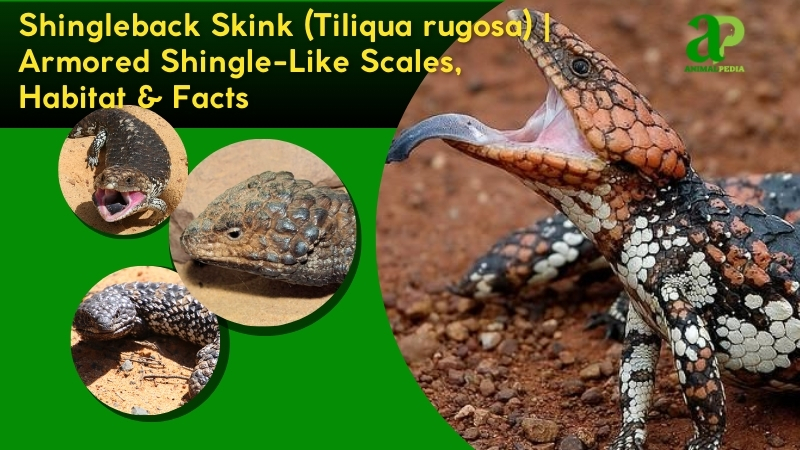
Scientific Classification
| KINGDOM | Animalia |
| PHYLUM | Chordata |
| SUBPHYLUM | Vertebrata |
| CLASS | Reptilia |
| ORDER | Squamata |
| FAMILY | Scincidae |
| GENUS | Tiliqua |
| SPECIES | rugosa |
Quick Facts
| Size | 12-18 in |
| Weight | 1.3-2 lb |
| Life span | 10-50 years |
| Habitat | Arid/semiarid Australia |
| Diet | Omnivore/insects/plants |
| Social Structure | Monogamous pairs |
| Key Features | Stumpy tail/blue tongue |
What Is Shingleback Skink?
The Shingleback Skink is a heavily armored, terrestrial lizard native to Australia, recognized by its distinctive, armor-like scales and a tail that mimics the shape of its head. Scientifically, it is classified as Tiliqua rugosa Gray, 1825, falling within the class Reptilia and the order Squamata [13]. Its common name is derived from the large, overlapping, shingle-like scales that provide an armored defense, while its scientific name, rugosa, is Latin for “wrinkled,” describing the textured nature of its skin [4, 17, 20]. While most taxonomists classify it within the genus Tiliqua, some experts argue for its own genus, Trachydosaurus, based on unique scalation and body structure [4, 17, 15]. This debate highlights the species’ unique position in its taxonomic family.
This lizard is also known by many other names that speak to its key attributes. It is widely called the Bobtail Lizard due to its short, stumpy tail, and the Sleepy Lizard because of its characteristically slow movements [4, 17, 11]. It is also known as the Two-headed Skink, an informal name stemming from the tail’s resemblance to its head, a feature that can confuse predators [4, 17, 11]. Understanding the animal’s various names reveals insights into its most prominent features. Now that we have established the Shingleback Skink’s place in the animal kingdom, we can explore its distinctive physical form. This includes the fascinating armored scales and the other features that make it so recognizable.
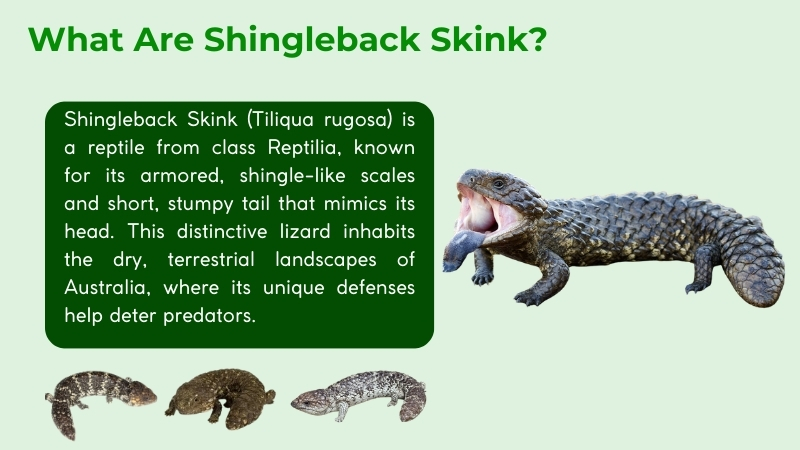
What Does Shingleback Skink Look Like?
The Shingleback Skink’s appearance is defined by a stout, heavy body and a prominent, broad triangular head, supported by short, sturdy limbs. The skink’s dorsal coloration is often a blend of brown, reddish-brown, or dark grey, forming irregular bands or blotches that create a cryptic pattern, allowing it to camouflage with its surroundings [4, 20]. The unique texture of its skin, formed by large, bony, and overlapping scales, contributes to its armored appearance, providing a formidable defense against potential predators. The skink’s most unique feature, its short, stumpy tail, adds to its distinctive silhouette and has led to its common name as the “Bobtail Lizard” [1, 4].
The skink’s physical profile is distinguished by five primary features. These include its armored scales, its short, bulbous tail, a broad, triangular head, short limbs, and its vibrant blue tongue. These characteristics work together to serve crucial functions for its survival in the wild.
- Armored Scales: The species is protected by large, keeled, overlapping scales that resemble shingles on a roof [4, 17]. These scales are underlaid with bony plates called osteoderms, forming a robust armor that discourages predators from a direct attack [9]. This natural defense system is a primary reason for its survival against larger animals.
- Short, Bulbous Tail: This unique tail is a key element of its defense and survival [4]. The tail stores fat reserves, providing essential energy during periods of food scarcity [4]. More notably, its blunt, head-like shape serves as a form of mimicry, confusing predators and allowing the lizard to escape from a tail grab [1, 20].
- Broad, Triangular Head: The skink’s head is disproportionately large and features a powerful jaw, enabling it to crush tough-shelled insects, snails, and other food sources [13]. This broad head is a defining physical characteristic and a testament to its diet.
- Short Limbs: The legs are small and robust, located at the sides of the body [4]. This configuration gives the skink a characteristic slow, waddling gait, which is effective for its terrestrial lifestyle but makes it vulnerable to fast-moving threats.
- Vibrant Blue Tongue: When threatened, the skink opens its mouth wide and extends a large, dark blue tongue in a display of defense [20]. This sudden flash of color, combined with a loud hiss, is intended to startle and intimidate predators, creating a moment for the skink to retreat [20].
Sexual dimorphism in this species is not overtly apparent, with males and females sharing similar body structures and coloration. However, males may exhibit slightly larger heads compared to females of similar size. Beyond its striking appearance, the Shingleback Skink has a size and weight that are central to its life. We can gain a clearer understanding of its biology by examining the metrics that define its physical presence.
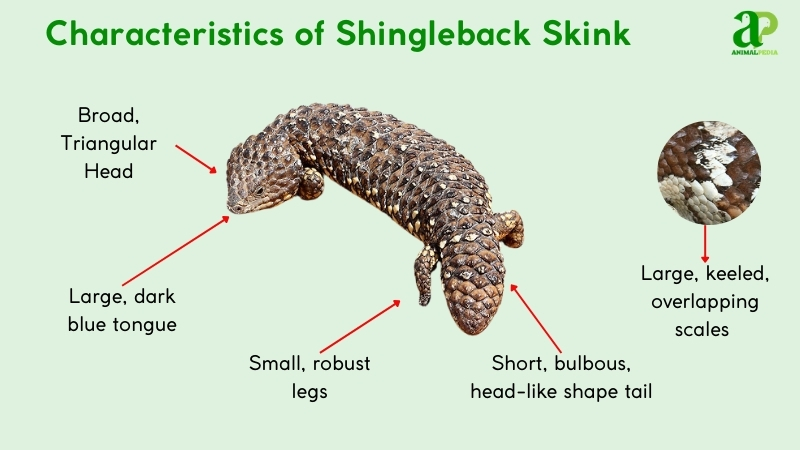
How Big is Shingleback Skink?
Adult Shingleback Skinks typically reach an average total length of 410 mm (16 inches) and weigh between 600-900 g (1.3-2 pounds). Males and females are of similar length, but males are generally heavier, especially during the mating season. The table below highlights the average size differences between the sexes.
| Characteristic | Male | Female |
| Length | 300-450 mm (11.8-17.7 in) | 300-400 mm (11.8-15.7 in) |
| Weight | 700-1000 g (1.5-2.2 lbs) | 600-900 g (1.3-2 lbs) |
Shingleback Skinks are born as live young, with a single litter size ranging from one to four offspring [5]. Hatchlings are surprisingly large, often measuring around 10 cm (4 inches) and weighing up to 25% of their mother’s body weight [5]. They grow into adults over several years, reaching their full size and weight, which is comparable to that of a small housecat. The skink’s size is perfectly adapted for its home environment. Let’s shift our attention to its natural habitat, which spans a wide range of climates across Australia.
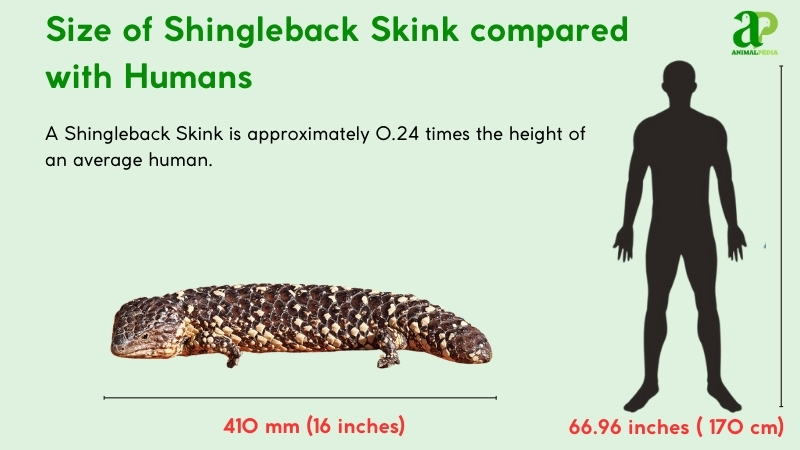
Where Does Shingleback Skink Live?
The Shingleback Skink is found throughout most of southern and western mainland Australia, inhabiting a range of arid and semi-arid environments [13]. Its geographic distribution spans from the coastal regions of Western Australia to the inland areas of New South Wales, Victoria, and South Australia [13]. The species is highly adaptable, thriving in a variety of habitat types, including deserts, woodlands, and grasslands [4, 10]. It prefers areas with abundant ground cover, such as leaf litter, fallen logs, and burrows [4, 10]. Shinglebacks are terrestrial animals, with no recorded elevation or depth range, and are not known to establish distinct territories, instead using a home range of several acres [5]. Their survival is dependent on a climate that provides a consistent temperature range and access to sun for thermoregulation. Having explored its physical home, we will now examine the day-to-day actions of the Shingleback Skink. Its unique behaviors and survival strategies are key to its success in the wild.
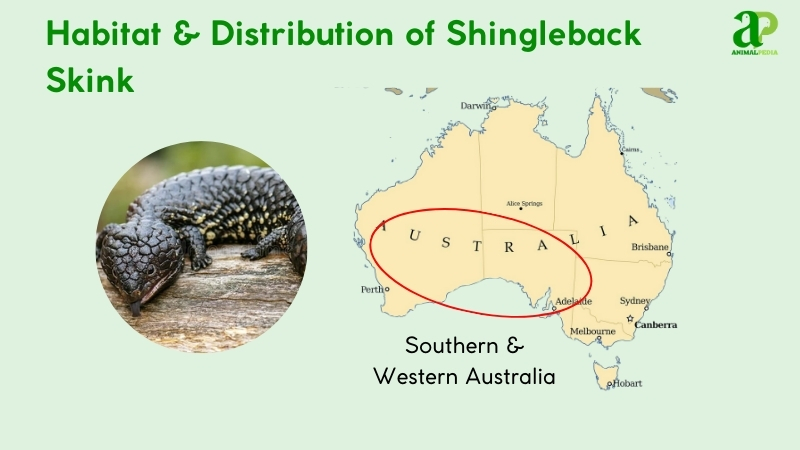
How Does Shingleback Skink Behave?
The Shingleback Skink is a diurnal and solitary reptile with a deliberate pace and omnivorous diet. Its behavior is characterized by a slow, methodical approach to movement and foraging.
- Diet and Feeding: The skink has a broad, omnivorous diet and forages opportunistically on a variety of plants and invertebrates.
- Movement and Abilities: The skink is a slow-moving terrestrial lizard, relying on its armored scales and camouflage as its primary defense mechanisms.
- Daily/Seasonal Patterns: It is a diurnal species, active primarily during the day to bask in the sun and forage for food.
This section provides a detailed look into the behaviors that define the Shingleback Skink’s life.
Diet and Feeding
The Shingleback Skink is an omnivore, primarily consuming plants and invertebrates. Its diet consists of a variety of native flowers, fruits, and leaves, which make up a significant portion of its intake [5]. Invertebrates, such as snails, beetles, and insects, are also a major food source [5]. The skink’s hunting behavior is methodical; it forages slowly, using its keen sense of smell to locate food [5]. Its powerful jaws enable it to crush hard-shelled prey like snails. The feeding pattern is opportunistic, with the skink consuming available food as it is encountered. A special adaptation of this skink is its ability to extract water from the food it eats, allowing it to survive in arid environments where water sources are scarce [13].
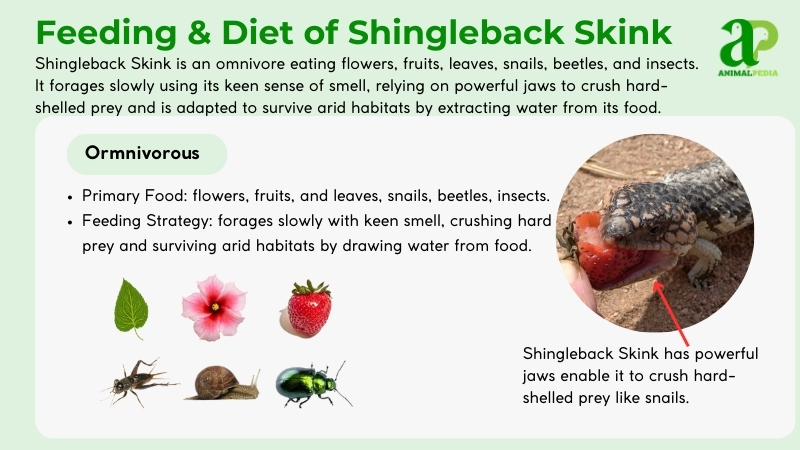
Are Shingleback Skinks Venomous?
Shingleback Skinks are not venomous. The species is a non-venomous lizard with no known venom glands or venom delivery system. When encountered, a shingleback’s bite is not dangerous to humans. It may cause a painful pinch or break the skin, but it poses no serious health risk [4]. The skink’s defensive behavior towards humans is to hiss, open its mouth wide, and show its blue tongue [20]. If this is not enough to deter a perceived threat, it may resort to a strong bite, holding on with its powerful jaws [17]. Guidelines for encountering these lizards involve giving them space and avoiding direct contact, as they will typically move away on their own.
Movement and Abilities
The Shingleback Skink moves with a slow, waddling gait, relying on its terrestrial nature for survival. Its movement types primarily consist of a slow crawl across the ground, and it is capable of short bursts of speed when threatened. The species can run at speeds up to 12.8 km/h (8 miles per hour) [1]. Its short, robust limbs and body structure are optimized for burrowing and moving through dense vegetation. The species has special abilities that are highly adapted for its environment. For example, its short tail stores fat reserves, providing essential energy during periods of food scarcity [4]. The tail also aids in balancing and can be used to confuse predators due to its head-like appearance [1, 20].
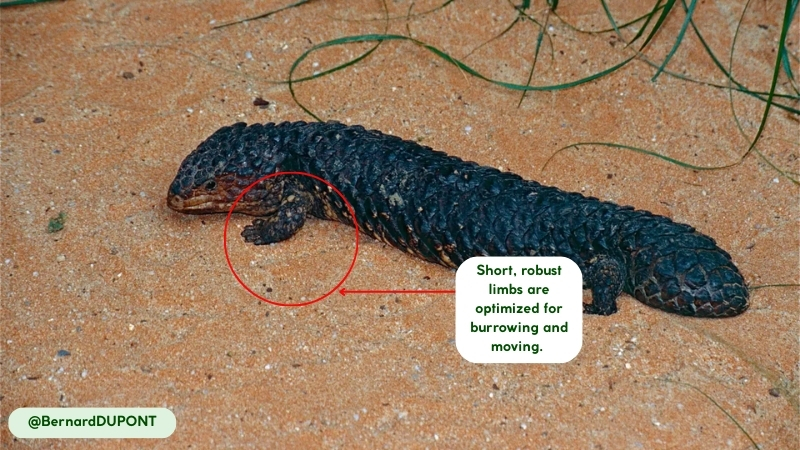
Daily/Seasonal Patterns
Shingleback Skinks are diurnal, meaning they are active during the day. Their daily activity cycle is divided into several periods. From sunrise to mid-morning, they are active, basking in the sun to regulate body temperature [5]. They forage for food and water in the mid-morning to late afternoon, a time when they are most mobile [5, 13]. In the evening, the skink seeks shelter under logs, rocks, or in burrows to rest and hide from predators [5]. The seasonal patterns of this species are influenced by temperature. They are most active during the warmer months of spring and summer, when food is abundant [5].
During the colder winter months, the shingleback skink may enter a state of brumation, a period of inactivity and slowed metabolism [5]. The species does not migrate, remaining within a defined home range throughout its life [10]. The survival of the species depends on more than its daily routines. Our next discussion will cover its unique reproductive cycle and how it ensures the next generation of this remarkable reptile.
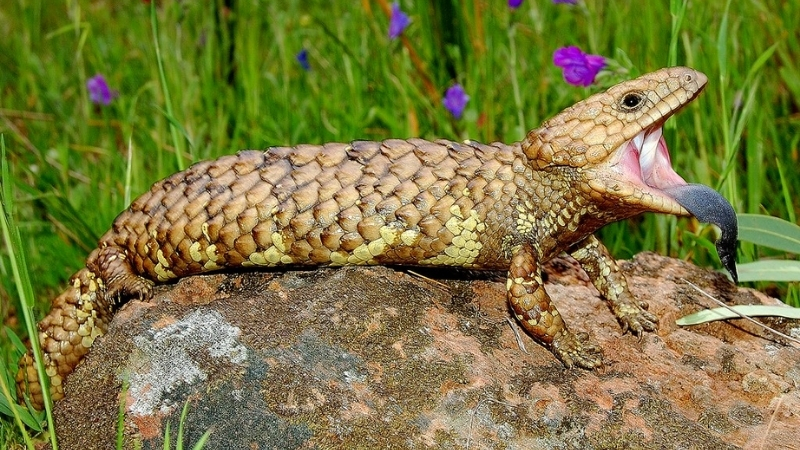
How Does Shingleback Skink Reproduce?
The Shingleback Skink is a viviparous reptile, giving birth to live young rather than laying eggs. Mating typically occurs in the Australian spring, between September and November [5]. The courtship behavior is unique, with males forming strong, monogamous pair-bonds that can persist for many years [3, 5]. During the mating season, these pairs travel and forage together. After a gestation period of several months, females give birth to a small litter.
A single litter size ranges from one to four offspring, which are notably large at birth, often weighing up to 25% of the mother’s body weight [5]. This large size at birth means the young are relatively developed and independent soon after they emerge [5]. Parental care is minimal, with the young dispersing from their mother after a few days. The seasonal breeding pattern is influenced by environmental triggers such as rising temperatures and increased food availability. The process of reproduction gives us insight into the life cycle of the Shingleback Skink. This leads us to the next point about the longevity of the species and the factors that contribute to a long life.
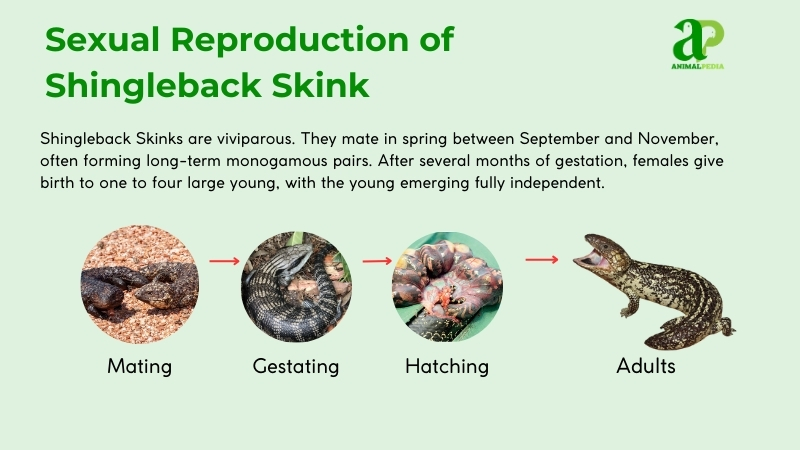
How Long Does Shingleback Skink Live?
Shingleback Skinks live approximately 20 to 30 years in the wild, though they can reach lifespans of up to 50 years under ideal conditions [13]. Their longevity is dependent on multiple factors, including diet, habitat quality, predation, and human impact. They reach sexual maturity between three and five years of age, at which point they are ready to breed [5].
Longevity is influenced by their environment. A consistent food supply, a secure habitat with ample hiding places, and low predation pressure contribute to a longer lifespan. In contrast, threats such as habitat destruction, vehicle traffic, and illegal trafficking can reduce the average lifespan [10]. Understanding its long lifespan prompts a broader question about its place in the ecosystem and its relationship with humans. We will now investigate the benefits this reptile provides to its environment and to human endeavors.
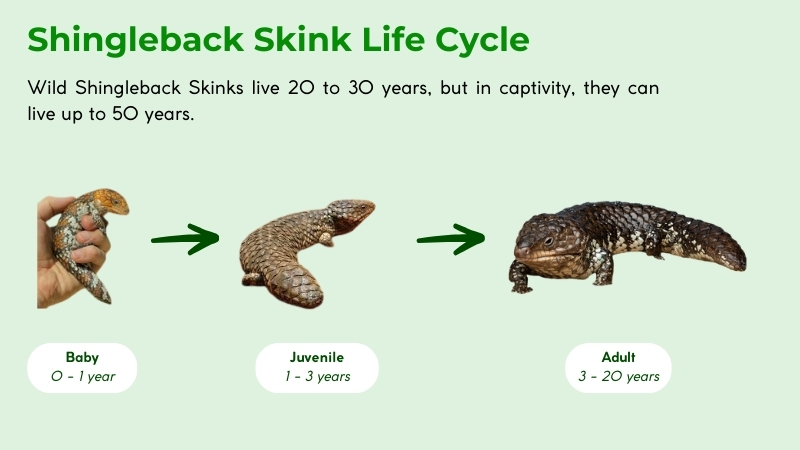
Is Shingleback Skink Beneficial to Humans?
Shingleback Skinks provide benefits to humans through their role as natural pest controllers and their significance in scientific research. They consume common garden pests, such as snails and insects, which reduces the need for chemical pesticides in their native habitats [5]. This ecological service directly aids horticulture and agriculture. Beyond this practical role, the species holds importance in scientific study. Research on their unique pair-bonding behavior has contributed to the understanding of animal social structures and monogamy [3, 5]. Their distinctive biology, including specialized scales and a unique tail, has made them a subject of interest in evolutionary and ecological studies [1, 11]. They are also a protected species in Australia, highlighting their cultural and biological value to the nation [7]. Given the positive impact of the Shingleback Skink, it is important to address its conservation status. Let’s look at the threats it faces and the efforts being made to protect its population.
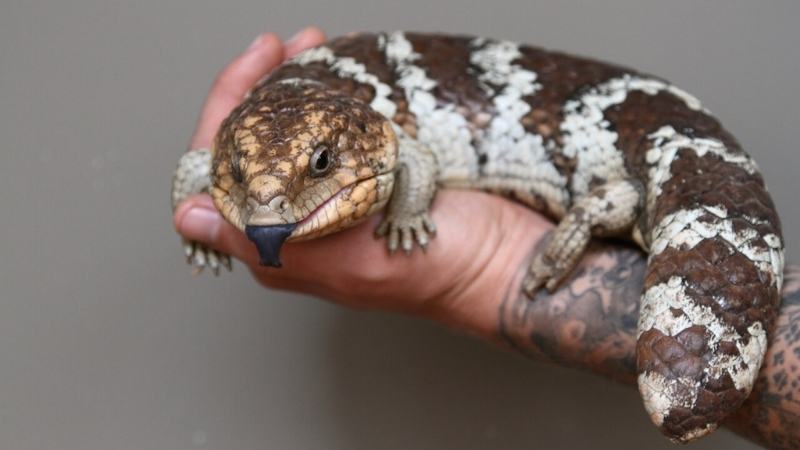
Is Shingleback Skink Endangered?
The Shingleback Skink is not currently classified as endangered; its conservation status is officially designated as Least Concern by the International Union for Conservation of Nature (IUCN) [13]. This status reflects its wide distribution and a stable overall population. However, regional populations face specific threats [10]. The primary threats include habitat destruction from agricultural development and urbanization, which fragment their home ranges [5, 10]. Vehicle collisions also pose a significant risk, particularly where roads intersect their territories [5]. The illegal wildlife trade represents another major threat, as the species is highly sought after as a pet, leading to illegal trafficking [10, 14]. Individuals can contribute to their survival by being aware of wildlife corridors, reducing road speeds in their habitats, and reporting any suspicious activity related to illegal animal trade. Its conservation status is a testament to its resilience and adaptability. To continue exploring this creature, we have compiled a list of fascinating facts that highlight some of its most extraordinary traits.
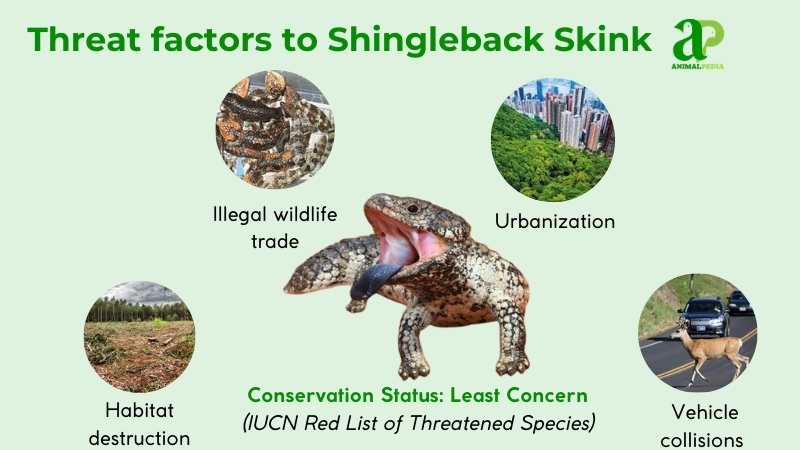
Frequently Asked Questions About Shingleback Skink
Are Shingleback Skinks Good Pets?
While Shingleback Skinks are not a venomous species and can be calm, their care is complex. They are a protected species in Australia, so obtaining one as a pet in other regions requires strict legal compliance and specific husbandry knowledge.
Can A Shingleback Skink Shoot Its Tail For Defense?
A Shingleback Skink does not shoot its tail. It uses its stubby tail to store fat reserves and to confuse predators by mimicking a second head. This defensive posture is a form of mimicry, not an offensive act.
How Long Do Babies Stay With Shingleback Skink?
Shingleback Skink babies are live-born and remain with their mother for a brief period, typically a few days. They are large and relatively independent at birth, dispersing to find their own food and shelter shortly after emerging.
How Do Shingleback Skinks Shed Their Skin?
Shingleback Skinks shed their skin in small, individual patches rather than a single piece. The shedding process occurs over a period of weeks, and the old skin is often consumed by the lizard to recycle nutrients.
Do Shingleback Skinks Experience Scarring From Social Interactions?
Physical altercations are rare, but when they occur, they can cause minor scarring. Lizards, including the shingleback skink, possess remarkable healing abilities, and minor wounds from territorial disputes or mating can heal without permanent marks [8].
Conclusion
The Shingleback Skink is a captivating creature of the Australian arid lands. Its armored scales, unique tail, and remarkable social behaviors, including long-term monogamous pair-bonds, demonstrate its incredible adaptability. From its role as a natural pest controller to its contribution to scientific research, the species holds significant ecological value. At Animal Pedia, we are dedicated to providing comprehensive and accurate information about the world’s diverse fauna. We invite you to explore more of our content and deepen your understanding of the animals that inhabit our planet.




